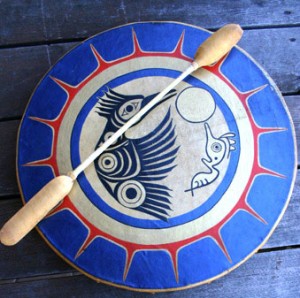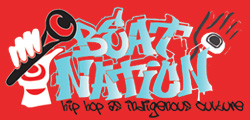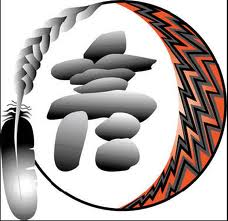I think Digital Drum, produced by the Aboriginal Peoples Television Network (APTN), is a fitting post to end my contribution to this blog on for many reasons. First, the idea of user generated content is very forward thinking and appeals to multi-media artists, particularly youth, in many ways as it a) requires no real experience to speak of b) no need to have a diverse portfolio or series of high-profile references c) requires only a little bit of ingenuity and minor technical skills to operate. The best part of this type of content is that it allows people who have something to say to be heard without having to jump through the hoops of the massive corporate world of mainstream media. What this means in a First Nations context is that it is possible to maintain creative control of the elements of storytelling and say what you want to say how you want to say it.
Second, Digital Drum offers educational resources and encourages content that relates to First Nations values, including respect for elders and reverence for the natural world, which has the potential to have a very positive influence on aboriginal youth culture. The site describes its purpose as “a place for Aboriginal Cultural expression — for example: storytelling, media literacy, community traditions, activism and music.” The About section goes further to describe the site’s main focuses as being to “…engage youth and increase their awareness of each other. Making us all feel youth have a sense of citizenship and pride in their Aboriginal heritage – both online and in the real-world. “ All very wonderful ideas that really allow the mixing of traditional values with modern realities.
Unfortunately, Digital Drum, which in theory could be a great resource and space for research and learning related to First Nations culture, is in a state of disrepair. It has seemingly been abandoned and left un-moderated, prone to the inappropriate ramblings of zealots and sales folks mingling with (and unfortunately discrediting) content that shows great skill and insight related to First Nation issues. Perhaps this is because most people tend to post their content in mainstream sites such as YouTube and the like?
Somehow Digital Drum reminds me of that house on the rez that has such a great view, but has been left to crumble and fade: The potential is there, but for some reason it’s been left unattended. Without the commitment to care for and nurture such spaces, they will be overrun and become irrelevant; great ideas smothered before they grow to their full potential. A little bit of paint and elbow grease, and what you have is a very powerful tool for engaging and educating. But that takes extraordinary commitment, encouragement and hard work in order to have those voices heard through the din of cyberspace. And I guess that is what our jobs are moving forward; working hard at finding a way to help aboriginal voices, filled with the pure and valuable knowledge of ancient ways, to ring loud and clear for the entire world to hear.






